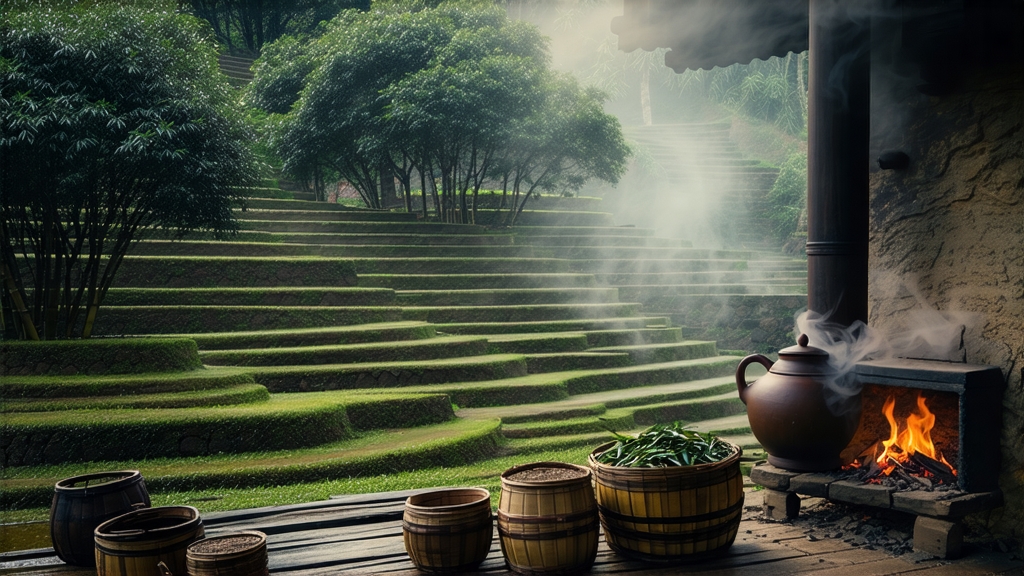
Tucked away in the subtropical hills of southern China’s Guangxi Zhuang Autonomous Region, Liu Bao tea has spent four centuries quietly perfecting the art of microbial alchemy. To the uninitiated it is merely another dark brick in the vast wall of Chinese “black” (actually post-fermented) teas, yet to the minority Yao and Zhuang peoples, dock-workers in Hong Kong, and seasoned tea traders along the historic Tea-Horse Road, Liu Bao is liquid history—an edible archive of climate, craft, and commerce.
The story begins in the small county of Cangwu surrounding the port town of Wuzhou. During the Ming dynasty, local growers discovered that leaves picked from the hardy Zhongyezhong cultivar tolerated the blistering summer heat and torrential monsoon rains better than the delicate spring greens favored in the north. Needing a product that could survive the long, humid journey to Guangdong and Southeast Asia, they copied the idea of “wet-piling” already experimented with in Yunnan, but adapted it to their own terroir: basaltic red soils rich in iron, a river delta thick with aquatic microbes, and bamboo forests that supplied both fuel and breathable packaging. By the Qing era, Liu Bao was being pressed into 37-kilogram baskets, loaded onto flat-bottomed river boats, and floated down the Xun Jiang to the Pearl River delta where dock laborers drank it to dispel dampness and merchants shipped it to Malaya, Indochina, and beyond. In 1801 the governor of Guangxi even memorialized the throne that “Wuzhou dark tea cures malaria among the frontier troops,” cementing Liu Bao’s reputation as both beverage and folk medicine.
Although officially grouped under the Chinese “hei cha” (dark tea) umbrella, Liu Bao is not a single style but a spectrum of ages, pile depths, and basket sizes. The most common commercial grades are:
- First-grade Song Ti (loose leaf, 1–2 years, light fermentation)
- Second-grade San Jian (three-basket blend, 3–5 years, medium fermentation)
- Third-grade Hua Zhuan (flower brick, 5–10 years, heavy fermentation)
- Vintage Gong Si (tribute basket, 15–40 years, microbial bloom visible as golden “jin hua” spores)
Each grade obeys the same four-step protocol—kill-green, rolling, wet-piling, and drying—but the duration of the critical “wo dui” (wet-pile) phase is what separates a bright, woody Song Ti from the camphor-laced depths of a 1980s Gong Si.
Crafting Liu Bao is a dialogue between human intention and microbial whim. Leaves are picked in late April when the monsoon begins, ensuring a moisture-laden leaf that oxidizes quickly. After a brief withering on bamboo mats, they are pan-fired at 280 °C for exactly four minutes—long enough to denature polyphenol oxidase but short enough to preserve leaf elasticity. While still warm, the leaves are rolled into tight strips that trap surface microbes inside the cell walls. The strips are then heaped 70 cm deep inside a pine-lined room where the temperature is allowed to climb to 55 °C and humidity hovers at 85 %. Every 48 hours the pile is turned, sprayed with mineral-rich well water, and covered with jute sacks to re-establish an anaerobic core. Over the next 20 to 35 days the dominant microflora shifts from Aspergillus niger to Blastobotrys adeninivorans, a yeast unique to the Wuzhou watershed that metabolizes caffeine into theobromine, giving Liu Bao its signature mellow stimulation. When the tea master detects a betel-nut and raw cacao bouquet, the pile is broken down and sun-dried on large bamboo trays for three consecutive mornings, allowing UV light to fix the color and halt further fermentation. Finally the tea is packed into double-layered baskets woven from river reeds; the inner layer breathes, the outer layer protects, and over decades the tea continues to inhale the terroir of the storage room—whether that is a riverside warehouse redolent of star anise or a limestone cave laced with moss.
To brew Liu Bao is to summon a miniature climate in a